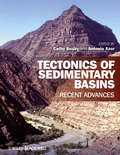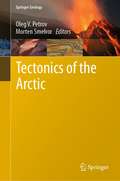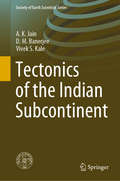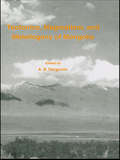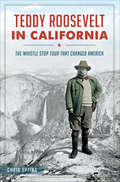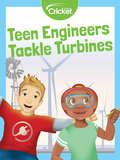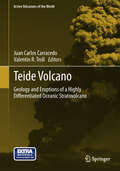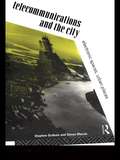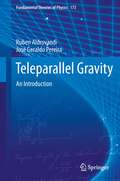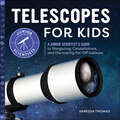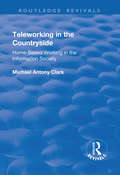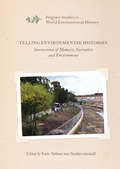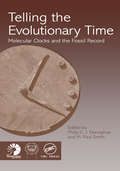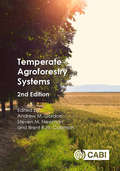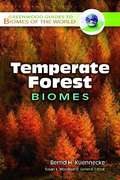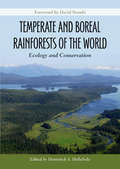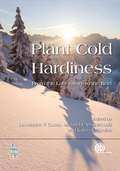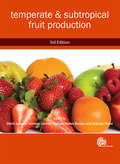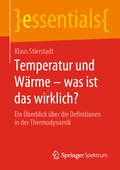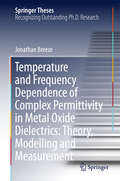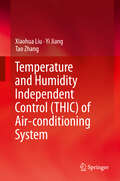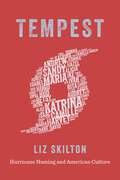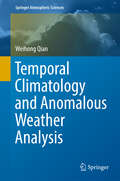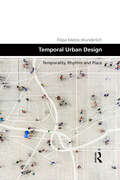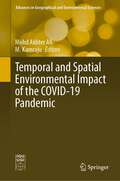- Table View
- List View
Tectonics of Sedimentary Basins
by Antonio Azor Pérez Cathy BusbyInvestigating the complex interplay between tectonics and sedimentation is a key endeavor in modern earth science. Many of the world's leading researchers in this field have been brought together in this volume to provide concise overviews of the current state of the subject.The plate tectonic revolution of the 1960's provided the framework for detailed models on the structure of orogens and basins, summarized in a 1995 textbook edited by Busby and Ingersoll. Tectonics of Sedimentary Basins: Recent Advances focuses on key topics or areas where the greatest strides forward have been made, while also providing on-line access to the comprehensive 1995 book.Breakthroughs in new techniques are described in Section 1, including detrital zircon geochronology, cosmogenic nuclide dating, magnetostratigraphy, 3-D seismic, and basin modelling. Section 2 presents the new models for rift, post-rift, transtensional and strike slip basin settings. Section 3 addresses the latest ideas in convergent margin tectonics, including the sedimentary record of subduction intiation and subduction, flat-slab subduction, and arc-continent collision; it then moves inboard to forearc basins and intra-arc basins, and ends with a series of papers formed under compessional strain regimes, as well as post-orogenic intramontane basins. Section 4 examines the origin of plate interior basins, and the sedimentary record of supercontinent formation.This book is required reading for any advanced student or professional interested in sedimentology, plate tectonics, or petroleum geoscience.Additional resources for this book can be found at: www.wiley.com/go/busby/sedimentarybasins.
Tectonics of the Arctic (Springer Geology)
by Morten Smelror Oleg V. PetrovThe book gives an overview of the tectonic, geological, potential fields, etc maps of the Arctic that were compiled during geological and geophysical studies conducted in the Arctic over the past 15 years under the International project “Atlas of Geological Maps of the Circumpolar Arctic at a scale of 5M” and presents the results of geological, geophysical, paleogeographic and tectonic studies carried out in the Arctic Ocean and the Eastern Arctic during the implementation of national mapping and scientific programmes and studies intended to provide scientific substantiation for the extension of the continental shelf (ECS). Given its scope, the book will appeal to a wide range of geologists.
Tectonics of the Indian Subcontinent (Society of Earth Scientists Series)
by Vivek S. Kale A.K. Jain D.M. BanerjeeThis books documents the salient characters of the tectonic evolution of the Indian subcontinent. It showcases the well investigated subcontinent of Gondwana. The book is linked to an updated geological and tectonic map of this region on 1:12,000,000 in scale. The Indian subcontinent displays almost uninterrupted and unique the geological history since about Eo-Archean (~3800 Ma) to recent, with the development of many Proterozoic deformed and metamorphosed fold belts around Archean nuclei, and enormously thick undeformed platform deposits. After their stabilization during late Proterozoic, the subcontinent underwent Paleozoic rifting and deposition of coal-bearing thick sequences, followed by enormously-thick outpouring of Deccan volcanics as a consequence of huge mantle plume. The youngest event in its evolution is the Cenozoic Himalayan Orogenic Mountains, spanning the area between Nanga Parbat and Namcha Barwah; a part of which extends both in Pakistan and Myanmar.
Tectonics, Magmatism and Metallogeny of Mongolia
by A. B. DergunovThis volume provides the first systematic description of the most important geological structures of Mongolia and discusses the main features of these structures and their interactions. The main characteristics of magmatism are described for each stage of tectonic development and the evolution of magmatism is considered with reference to lithosphere development. Mongolia is a key region of the world and this volume provides a primary source of reference for postgraduates and researchers.
Teddy Roosevelt in California: The Whistle Stop Tour That Changed America
by Chris EptingThe camping trip taken by the &“conservationist president&” that put America&’s national parks on the map—from the award-winning author of Roadside Baseball. During his whirlwind 1903 tour of the western states, President Theodore Roosevelt paid his first visit to California. In between the appearances and pageantry, he embarked on three days of epic adventure in the wilderness of Yosemite with the famous and influential naturalist John Muir. A lover of the rugged outdoors, Roosevelt was humbled and impressed by the camping trip, which proved to be one of the most important sojourns in presidential history. Through firsthand accounts, speeches and rare photographs, author Chris Epting tells the story of a great and profound journey that had a lasting effect on conservation history and the National Park System.
Teen Engineers Tackle Turbines
by Mary Beth CoxTurbine designers are always looking for new ways to get more energy from wind.
Teide Volcano
by Juan Carlos Carracedo Valentin R. TrollTeide Volcano has many different meanings: For the Guanche aborigines, who endured several of its eruptions, it was Echeide (Hell). Early navigators had in Teide, a lifesaving widely visible landmark that was towering over the clouds. For the first explorers, Teide was a challenging and dangerous climb, since it was thought that Teide's peak was so high that from its summit the sun was too close and far too hot to survive. Teide was considered the highest mountain in the world at that time and measuring its height precisely was a great undertaking and at the time of global scientific significance. For von Buch, von Humboldt, Lyell and other great 18th and19th century naturalists, Teide helped to shape a new and now increasingly 'volcanic' picture, where the origin of volcanic rocks (from solidified magma) slowly casted aside Neptunism and removed some of the last barriers for the development of modern Geology and Volcanology as the sciences we know today. For the present day population of Tenerife, living on top of the world's third tallest volcanic structure on the planet, Teide has actually become "Padre Teide", a fatherly protector and an emblematic icon of Tenerife, not to say of the Canaries as a whole. The UNESCO acknowledged this iconic and complex volcano, as "of global importance in providing evidence of the geological processes that underpin the evolution of oceanic islands". Today, 'Teide National Park' boasts 4 Million annual visitors including many 'volcano spotters' and is a spectacular natural environment which most keep as an impression to treasure and to never forget. For us, the editors of this book, Teide is all of the above; a 'hell of a job', a navigation point on cloudy days, a challenge beyond imagination, a breakthrough in our understanding of oceanic volcanism that has shaped our way of thinking about volcanoes, and lastly, Teide provides us with a reference point from where to start exploring other oceanic volcanoes in the Canaries and beyond. Here we have compiled the different aspects and the current understanding of this natural wonder.
Telecommunications and the City: Electronic Spaces, Urban Places
by Steve Graham Simon MarvinTelecommunications and the City provides the first critical and state-of-the-art review of the relations between telecommunications and all aspects of city development and management.Drawing on a range of theoretical approaches and a wide body of recent research, the book addresses key academic and policy debates about technological change and the future of cities with a fresh perspective. Through this approach, the complex and crucial transformations underway in cities in which telecommunications have central importance are mapped out and illustrated. Key areas where telecommunications impinge on the economic, social, physical, enviromental and institutional development of cities are illustrated by using boxed extracts and wide range of case study examples from Europe, Japan and North America.Rejecting the extremes of optimism and pessimism in current hype about cities and telecommunications, Telecommunications and the City offers a sophisticated new perspective through which city-telecommunications relations can be understood.
Teleparallel Gravity
by Ruben Aldrovandi Jose G PereiraTeleparallel Gravity (TG) is an alternative theory for gravitation, which is equivalent to General Relativity (GR). However, it is conceptually different. For example in GR geometry replaces the concept of force, and the trajectories are determined by geodesics. TG attributes gravitation to torsion, which accounts for gravitation by acting as a force. TG has already solved some old problems of gravitation (like the energy-momentum density of the gravitational field). The interest in TG has grown in the last few years. The book here proposed will be the first one dedicated exclusively to TG, and will include the foundations of the theory, as well as applications to specific problems to illustrate how the theory works.
Telescopes for Kids: A Junior Scientist's Guide to Stargazing, Constellations, and Discovering Far-Off Galaxies (Junior Scientists)
by Vanessa ThomasExplore the mysteries of the night sky with the Junior Scientists series for kids ages 6 to 9Scan the skies for 40 incredible sights with a book that shows budding scientists how to use a telescope for kids. You'll learn how to choose a telescope, set it up, and seek out the wonders of the Northern Hemisphere, from the Big Dipper to the Whirlpool Galaxy.Detailed visual guides—Illustrations of each star, planet, and more make them easier to spot— and once you can identify the major ones, you can use them to find others with any telescope for kids.Outer space school—Discover what time of year it's easiest to see different objects in the sky, the life cycle of a star, how galaxies are cataloged, and more!Fun facts—Find out where the constellations get their names and why looking at the stars means you're actually looking back in time!See what's happening out in the cosmos with this guide to making the most of a telescope for kids.
Teleworking in the Countryside: Home-Based Working in the Information Society (Routledge Revivals Ser.)
by Michael Antony ClarkThis title was first published in 2000. Since the 1970s there has been widespread debate on the potential of information communication technologies on the organization of work and in particular, the implications of and opportunities engendered through telework and the decentralization of the workplace. However, despite the possible spatial, cultural, social and economic implications, much of the telework debate has been informed by anecdotal examples, journalistic reporting and individual forecasts. This book aims to further the debate by analyzing the scale, nature and experience of telework in the countryside. It examines how and by whom, telework is set up, and what policy and social changes are taking place to facilitate it in rural areas. Individual teleworkers and the organizations using them are questioned to assess whether rural teleworking is proving as advantageous in practice as it is thought to be in theory. Its conclusions suggest that teleworking may not yet be the solution to the many rural problems such as unemployment and depopulation and that businesses and local authorities still need to develop their policies and strategies to allow this type of working to reach its potential.
Telling Environmental Histories: Intersections of Memory, Narrative and Environment (Palgrave Studies in World Environmental History)
by Katie Holmes Heather GoodallThis collection explores the intersections of oral history and environmental history. Oral history offers environmental historians the opportunity to understand the ways people's perceptions, experiences and beliefs about environments change over time. In turn, the insights of environmental history challenge oral historians to think more critically about the ways an active, more-than-human world shapes experiences and people. The integration of these approaches enables us to more fully and critically understand the ways cultural and individual memory and experience shapes human interactions with the more-than-human world, just as it enables us to identify the ways human memory, identity and experience is moulded by the landscapes and environments in which people live and labour. It includes contributions from Australia, India, the UK, Canada and the USA.
Telling the Evolutionary Time: Molecular Clocks and the Fossil Record
by Philip C. J. Donoghue M. Paul SmithDetermining the precise timing for the evolutionary origin of groups of organisms has become increasingly important as scientists from diverse disciplines attempt to examine rates of anatomical or molecular evolution and correlate intrinsic biological events to extrinsic environmental events. Molecular clock analyses indicate that many major groups
Temperate Agroforestry Systems (Cabi Publishing Ser.)
by Andrew M. Gordon Steven M. Newman Brent R.W. ColemanAgroforestry is a land use system that allows for the concurrent production of trees and agricultural crops and/or animals from the same piece of land. It has a rich history of development and has been practised in some parts of the world for more than 6,000 years. In 1997, CABI published the seminal book on this subject,Temperate Agroforestry Systems, which was a break from the norm as almost all agroforestry texts up to that date were only relevant to tropical areas. The book explored the development of temperate agroforestry and agroforestry systems, concentrating on those areas within temperate zones where the greatest advances, adoptions and modifications had taken place up to that time: North and South America, China, Australia, New Zealand and Europe. This second fully-updated and expanded edition includes additional chapters on India and Chile and, as a result of ongoing advances in the field, separate chapters on the US, Canada, the UK and continental Europe. Today's challenges of climate change, population growth and food security, in concert with the ongoing global requirement for the energy and water needed for a resilient agricultural paradigm, can be met through the wide-scale adoption of agroforestry practices, in both tropical regions and temperate zones. The 2nd edition ofTemperate Agroforestry Systems brings together many examples of temperate agroforestry and will make valuable reading for all those working in this area as researchers, practitioners and policy makers. The book is also of importance to students and teachers of agriculture, ecology, environmental studies and forestry in temperate regions.
Temperate Forest Biomes (Greenwood Guides to Biomes of the World)
by Bernd H. KuenneckeThe tropical forests my provide much of our oxygen world-wide, but the temperate forests sustain us, and here Kuennecke (Radford U.) takes a very close look at temperate forest biomes, temperate broadleaf deciduous forests, Mediterranean woodlands and stands of scrub in a temperate environment. Focusing on a range of temperate forest biomes, he gives a general overview at a global scale and analyzes specific biomes in detail, so much so that chapters can stand on their own. He keeps undergraduates in mind, using a minimum of scientific jargon but respecting that which is needed, and organizes chapters geographically to cover virtually every temperate biome. He notes that all biomes overlap to some degree and explains the phenomenon, and also pays attention to the effects of climate and climate change. Annotation ©2009 Book News, Inc., Portland, OR (booknews.com)
Temperate and Boreal Rainforests of the World
by Dominick A. DellasalaTemperate rainforests are biogeographically unique. Compared to their tropical counterparts, temperate rainforests are rarer and are found disproportionately along coastlines. Because most temperate rainforests are marked by the intersection of marine, terrestrial, and freshwater systems, these rich ecotones are among the most productive regions on Earth. Globally, temperate rainforests store vast amounts of carbon, provide habitat for scores of rare and endemic species with ancient affinities, and sustain complex food-web dynamics. In spite of their global significance, however, protection levels for these ecosystems are far too low to sustain temperate rainforests under a rapidly changing global climate and ever expanding human footprint. Therefore, a global synthesis is needed to provide the latest ecological science and call attention to the conservation needs of temperate and boreal rainforests. A concerted effort to internationalize the plight of the world's temperate and boreal rainforests is underway around the globe; this book offers an essential (and heretofore missing) tool for that effort. DellaSala and his contributors tell a compelling story of the importance of temperate and boreal rainforests that includes some surprises (e.g., South Africa, Iran, Turkey, Japan, Russia). This volume provides a comprehensive reference from which to build a collective vision of their future.
Temperate and Subtropical Fruit Production
by David Jackson Michael Morley-Bunker John Palmer Peter Lyford David Mcneil R Chapman William Atkinson Graham Thiele Roy Edwards David Penman Norman LooneyEffective fruit production requires general knowledge of fruit husbandry such as nutrition, propagation, pruning and training, effects of climate and crop protection as well as specific cultivation techniques for each fruit. Fully revised and expanded to include organic fruit production, this new edition provides a thorough introduction to the cultivation of fruit found throughout the temperate and subtropical regions of the world.
Temperate and Subtropical Fruit Production
by John Palmer Peter Lyford R Chapman William Atkinson Roy Edwards David Penman David McNeilFully revised and expanded to include organic fruit production, this new edition provides a thorough introduction to the cultivation of fruit found throughout the temperate and subtropical regions of the world.
Temperatur und Wärme – was ist das wirklich?: Ein Überblick über die Definitionen in der Thermodynamik (essentials)
by Klaus StierstadtDieses essential vermittelt eine Einführung in die Thermodynamik und ermöglicht auch Einsteigern ein Verständnis der Thematik, welche eine Voraussetzung für die moderne Physik, die Chemie, Biologie und Technik ist. Der Schwerpunkt liegt auf den Grundlagen und aktuellen Fragestellungen. Das Buch schlägt eine Brücke zwischen den beiden Thermodynamik-Vorlesungen: der einfachen Wärmelehre im 1. oder 2. Semester und der anspruchsvollen Statistischen Physik im 5. Semester. Was Sie in der Zwischenzeit vergessen haben, oder was im 5. Semester vorausgesetzt wird, das finden Sie in diesem essential.
Temperature and Frequency Dependence of Complex Permittivity in Metal Oxide Dielectrics: Theory, Modelling and Measurement
by Jonathan BreezeThis thesis investigates the dielectric properties of metal-oxide ceramics at microwave frequencies. It also demonstrates for the first time that a theory of harmonic phonon coupling can effectively predict the complex permittivity of metal oxides as a function of temperature and frequency. Dielectric ceramics are an important class of materials for radio-frequency, microwave and emergent terahertz technologies. Their key property is complex permittivity, the real part of which permits the miniaturisation of devices and the imaginary part of which is responsible for the absorption of electromagnetic energy. Absorption limits the practical performance of many microwave devices such as filters, oscillators, passive circuits and antennas. Complex permittivity as a function of temperature for low-loss dielectrics is determined by measuring the resonant frequency of dielectric resonators and using the radial mode matching technique to extract the dielectric properties.There have been only a handful of publications on the theory of dielectric loss, and their predictions have often been unfortunately unsatisfactory when compared to measurements of real crystals, sometimes differing by whole orders of magnitude. The main reason for this is the lack of accurate data for a harmonic coupling coefficient and phonon eigenfrequencies at arbitrary q vectors in the Brillouin zone. Here, a quantum field theory of losses in dielectrics is applied, using results from density functional perturbation theory, to predict from first principles the complex permittivity of metal oxides as functions of frequency and temperature.
Temperature and Humidity Independent Control (THIC) of Air-conditioning System
by Tao Zhang Xiaohua Liu Yi JiangTemperature and Humidity Independent Control (THIC) of Air-conditioning System focuses on temperature and humidity independent control (THIC) systems, which represents a new concept and new approach for indoor environmental control. This book presents the main components of the THIC systems, including dehumidification devices, high-temperature cooling devices and indoor terminal devices. Other relevant issues, such as operation and control strategy and case studies, are also included. This book is intended for air-conditioning system designers and engineers as well as researchers working with indoor environments. Xiaohua Liu is an associate professor at the Building Energy Research Center, Tsinghua University, China. Yi Jiang is a member of the Chinese Academy of Engineering, the director of the Building Energy Research Center, Tsinghua University, China and the director of the China-USA Joint Research Center on Clean Energy. Tao Zhang is a Ph. D. candidate at the Building Energy Research Center, Tsinghua University, China.
Tempest: Hurricane Naming and American Culture (The Natural World of the Gulf South)
by Liz SkiltonLiz Skilton’s innovative study tracks the naming of hurricanes over six decades, exploring the interplay between naming practice and wider American culture. In 1953, the U.S. Weather Bureau adopted female names to identify hurricanes and other tropical storms. Within two years, that convention came into question, and by 1978 a new system was introduced, including alternating male and female names in a pattern that continues today. In Tempest: Hurricane Naming and American Culture, Skilton blends gender studies with environmental history to analyze this often controversial tradition. Focusing on the Gulf South—the nation’s “hurricane coast”—Skilton closely examines select storms, including Betsy, Camille, Andrew, Katrina, and Harvey, while referencing dozens of others. Through print and online media sources, government reports, scientific data, and ephemera, she reveals how language and images portray hurricanes as gendered objects: masculine-named storms are generally characterized as stronger and more serious, while feminine-named storms are described as “unladylike” and in need of taming. Further, Skilton shows how the hypersexualized rhetoric surrounding Katrina and Sandy and the effeminate depictions of Georges represent evolving methods to define and explain extreme weather events. As she chronicles the evolution of gendered storm naming in the United States, Skilton delves into many other aspects of hurricane history. She describes attempts at scientific control of storms through hurricane seeding during the Cold War arms race of the 1950s and relates how Roxcy Bolton, a member of the National Organization for Women, led the crusade against feminizing hurricanes from her home in Miami near the National Hurricane Center in the 1970s. Skilton also discusses the skyrocketing interest in extreme weather events that accompanied the introduction of 24-hour news coverage of storms, as well as the impact of social media networks on Americans’ tracking and understanding of hurricanes and other disasters. The debate over hurricane naming continues, as Skilton demonstrates, and many Americans question the merit and purpose of the gendered naming system. What is clear is that hurricane names matter, and that they fundamentally shape our impressions of storms, for good and bad.
Temporal Climatology and Anomalous Weather Analysis
by Weihong QianBy breaking down atmospheric variables into temporal climatologies and anomalies, this book demonstrates that all weather extremes and climatic events are directly associated with the anomaly component of atmospheric motion. We can use the anomaly-based synoptic chart and dynamical parameters to objectively describe these extremes and events. The conception and differences of weather, climate and general circulation tend to confuse us, because there are no clear physical definitions available for them. Weather extremes such as heat waves, cold surges, freezing rains, heavy rains, severe drought, unusual storm tracks, and tornados are common on our planet’s surface. Climatic events such as Arctic warming and declining sea ice have become hot topics in recent years. An approach based on breaking down total variables into temporal climatologies and anomalies can be used to identify general circulation, analyze climatic anomalies and forecast weather extremes. Accordingly, this book will appeal to students, teachers and forecasters in the field of weather and climate alike.
Temporal Urban Design: Temporality, Rhythm and Place (Design and the Built Environment)
by Filipa Matos WunderlichTemporal Urban Design: Temporality, Rhythm and Place examines an alternative design approach, focusing on the temporal aesthetics of urban places and the importance of the sense of time and rhythm in the urban environment. The book departs from concerns on the acceleration of cities, its impact on the urban quality of life and the liveability of urban spaces, and questions on what influences the sense of time, and how it expresses itself in the urban environment. From here, it poses the questions: what time is this place and how do we design for it? It offers a new aesthetic perspective akin to music, brings forward the methodological framework of urban place-rhythmanalysis, and explores principles and modes of practice towards better temporal design quality in our cities. The book demonstrates that notions of time have long been intrinsic to planning and urban design research agendas and, whilst learning from philosophy, urban critical theory, and both the natural and social sciences debate on time, it argues for a shift in perspective towards the design of everyday urban time and place timescapes. Overall, the book explores the value of the everyday sense of time and rhythmicity in the urban environment, and discusses how urban designers can understand, analyse and ultimately play a role in the creation of temporally unique, both sensorial and affective, places in the city. The book will be of interest to urban planners, designers, landscape architects and architects, as well as urban geographers, and all those researching within these disciplines. It will also interest students of planning, urban design, architecture, urban studies, and of urban planning and design theory.
Temporal and Spatial Environmental Impact of the COVID-19 Pandemic (Advances in Geographical and Environmental Sciences)
by Mohd Akhter Ali M. KamrajuThis book identifies, evaluates and reports the impacts of the COVID-19 pandemic on the physical, biological and socioeconomic environment, using the science and technology of geoinformatics. It encourages the environmental considerations in the future city and policy planning and decision-making. For example, according to the World Health Organization, 80% of people living in cities are exposed to polluted air that exceeds healthy levels. City planners have applied the developing concepts of sustainability to modern debates over how cities and regions should be reviewed, regenerated and reformed since the introduction of the concept in developmental science. During the COVID-19 pandemic, a remarkable drop in air pollution has been observed in India and other countries, which has accelerated the shift to green and sustainable development. Geoinformatics can provide solutions and resources for local, sustainable activities in education, health, sustainable agriculture, resource management and related fields. This book serves researchers in a variety of areas, including hazards, land surveys, remote sensing, cartography, geophysics, geology, natural resources, environment and geography.
